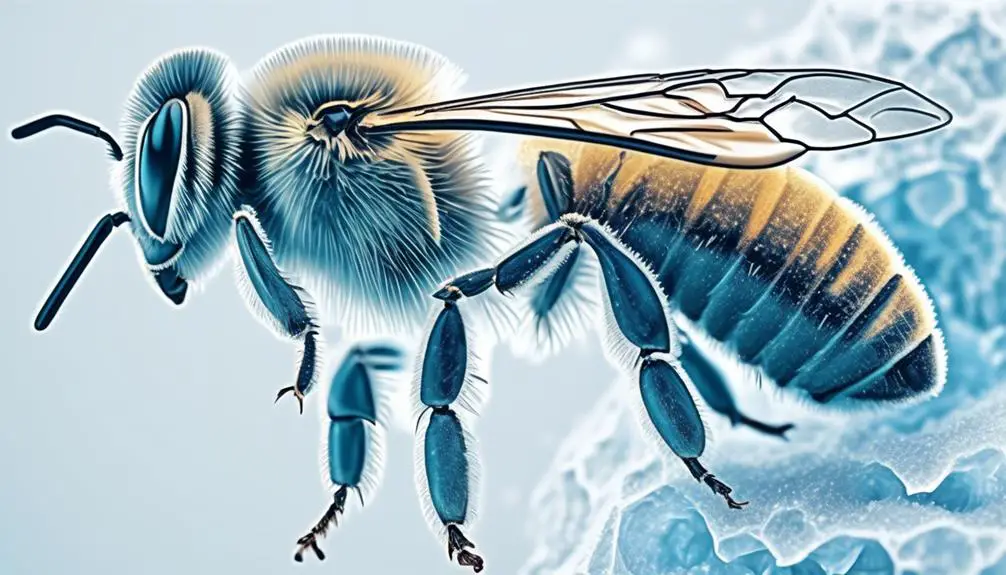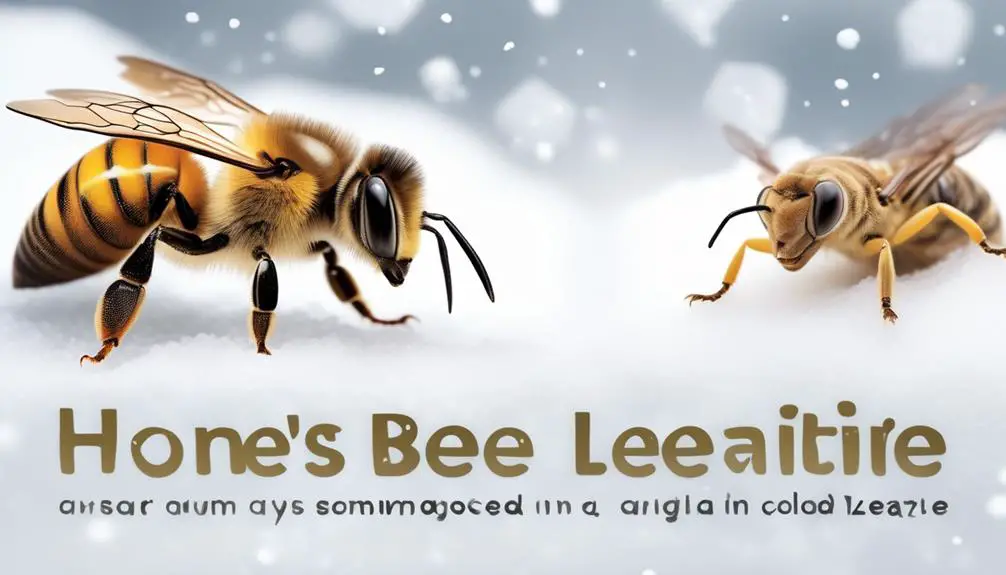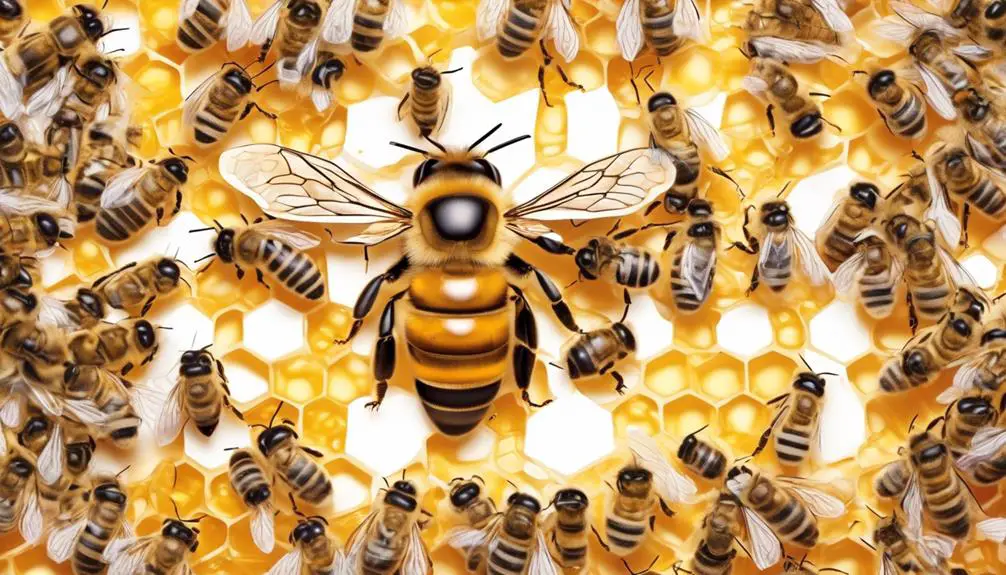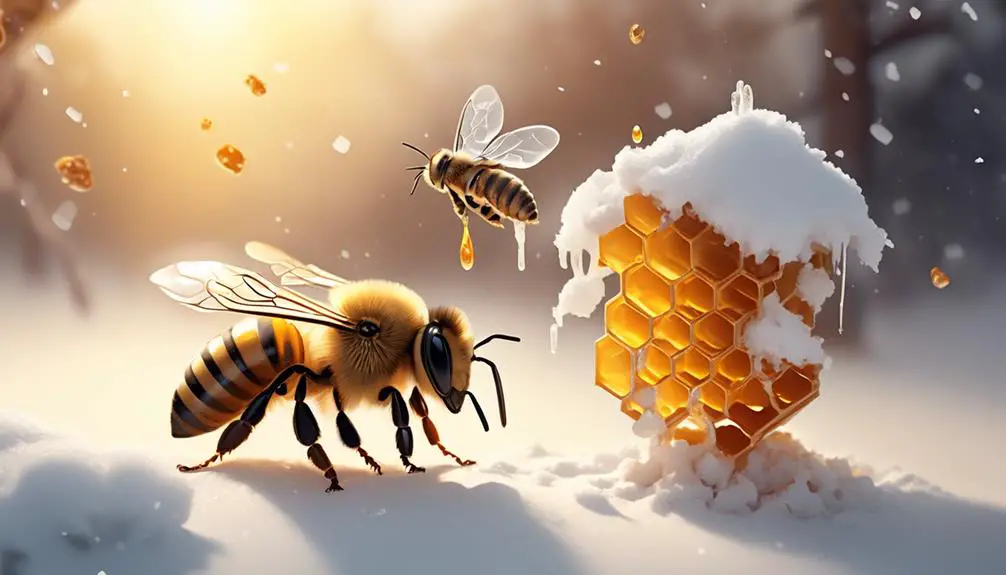Wondering whether honey bees are cold-blooded? Dive into the intriguing world of bee biology to discover this isn't a straightforward answer.

Are Honey Bees Cold Blooded
You know what they say, 'You can catch more flies with honey than with vinegar.' But, what if those flies were actually honey bees?
You've likely heard of creatures being 'cold-blooded' or 'warm-blooded,' but where do our striped pollinators fit into this? Are honey bees cold-blooded creatures succumbing to the whim of their environment's temperature, or do they have some level of control over their own body heat?
As you begin to explore the fascinating world of honey bee biology, you may find that the answer isn't as clear-cut as you'd expect.
Key Takeaways
- Honey bees are ectothermic organisms, relying on external sources for body heat regulation.
- Bees use various behavioral strategies like clustering, shivering, and ventilation to cope with temperature fluctuations.
- Winter survival strategies of honey bees include forming clusters, regulating food consumption, and undertaking cleansing flights.
- Ectothermy influences honey bee biology, social structures, and survival mechanisms significantly.
Understanding Honey Bee Biology

Diving into the fascinating world of honey bee biology, you'll find that these little creatures are ectothermic, or in simpler words, cold-blooded. Unlike humans and other endothermic animals, honey bees don't generate their own body heat. Instead, they rely on the environmental temperature to regulate their body heat. When it's cold, they'll cluster together in their hive to retain warmth, and when it's hot, they'll fan their wings to circulate air and cool down.
But don't be fooled into thinking that being ectothermic is a disadvantage. In fact, it's crucial for their survival. This trait allows bees to survive in a variety of climates, from the scorching heat of the desert to the freezing cold of the tundra.
Moreover, the bees' ectothermic nature plays a significant role in their complex social structure. The queen bee, for instance, requires a steady temperature of about 93 degrees Fahrenheit to lay eggs. So, the worker bees have to maintain this temperature by adjusting their activity levels accordingly. It's a fascinating interplay of biology and behavior that's central to the honey bee's survival.
The Concept of Cold-Blooded Creatures

Understanding the concept of cold-blooded creatures, like honey bees, involves delving into the intriguing realm of ectothermic biology. Ectothermic organisms, commonly called 'cold-blooded,' don't generate their own body heat. Instead, they depend on external sources like sunlight or warm surfaces to regulate their body temperature.
Your body, as a human, is endothermic, meaning it maintains a relatively constant internal temperature regardless of the environment. This isn't the case for honey bees. Like their reptile and amphibian counterparts, honey bees are ectothermic. Yet, don't be fooled into thinking they're helpless against the cold.
These industrious insects have a few tricks up their sleeves. They can shiver to generate heat, and in winter, they huddle together in a tight cluster, sharing body warmth to survive freezing conditions.
Temperature Regulation in Honey Bees

Now, let's explore how honey bees, these remarkable ectothermic creatures, manage to regulate their body temperature amidst fluctuating environmental conditions. Unlike mammals, bees don't maintain a steady body temperature. Instead, they've developed an array of sophisticated behavioral strategies to deal with temperature variations.
When it's chilly, bees huddle together, forming a 'winter cluster'. Inside this cluster, bees generate heat by shivering their flight muscles, yet they aren't flying. It's a neat trick, isn't it? The queen, their most valuable asset, is kept warm at the cluster's heart.
What about when it's hot? Bees ventilate the hive, fanning their wings to create a cooling airflow. Some even collect water, spreading it throughout the hive where it evaporates, effectively air conditioning their home. They're quite the little HVAC engineers!
However, don't think it's all about the weather outside. Bees also need to keep brood at a steady 34.5°C (94.1°F) for optimal development. So, they add or remove heat as needed, just like an incubator.
You see, honey bees aren't merely reacting to the environment. They're actively manipulating it, showcasing a remarkable ability to regulate temperature. It's an impressive display of nature's ingenuity, wouldn't you agree?
Winter Survival Strategies of Honey Bees

As winter looms, honey bees employ a host of clever survival strategies to weather the harsh conditions. Unlike other insects, they don't hibernate, but rather form a “winter cluster” in the heart of their hive. They tightly pack themselves together, the queen at the center, generating heat through the shivering of their flight muscles.
This winter cluster is a fascinating example of thermoregulation. The bees on the outside act as insulators, absorbing the cold and keeping the inner bees warm. The cluster continuously rotates, ensuring no bee stays on the colder exterior for too long.
They're also meticulous food storers, gathering plenty of nectar during warmer months, which is then converted into honey. This honey provides them with the energy needed to endure the winter months. They regulate their consumption, ensuring their stores last till spring.
You might wonder, how do they dispose of waste during this time? Well, they've got that figured out too. On warmer winter days, they perform “cleansing flights”, where they briefly leave the hive to defecate.
Misconceptions About Insect Thermoregulation

You might be clinging to a few misconceptions about how insects, like honey bees, regulate their body temperature. It's common to think of insects as cold-blooded, but this isn't entirely accurate. Insects are ectothermic, relying on external conditions to control their body heat.
Yet, honey bees are an exception to this rule. They aren't slaves to the whims of the weather, but can self-regulate their temperature. They do this through a process called thermoregulation. They generate heat by shivering their flight muscles, even when they're not flying.
Another misconception is that all insects hibernate during winter. Like other insects, honey bees don't hibernate. Instead, they cluster inside the hive and vibrate to generate heat, keeping the queen and the brood warm.
Lastly, you may believe that insects can't survive freezing temperatures. While it's true for many, honey bees demonstrate a remarkable resilience to cold. They manage to maintain a steady hive temperature around 93°F all year round.
Conclusion
So, are honey bees cold-blooded? Not quite. They're ectothermic, relying on their environment for heat. But they're also capable of generating their own warmth, using their flight muscles to maintain hive temperature.
In winter, they cluster together, sharing body heat to survive. So, forget the misconception that all insects are cold-blooded. Honey bees, with their complex temperature regulation, are an exceptional example of insect thermoregulation.


